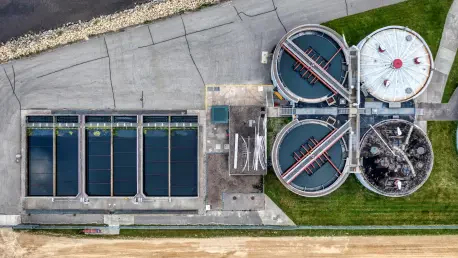In recent years, the water utilities sector has increasingly become a target for sophisticated cyber threats, underscored by ransomware attacks on major UK water companies like Southern Water and Thames Water. These incidents raise pressing concerns about the sector’s readiness to handle growing cybersecurity risks. The checks conducted to test their preparedness have uncovered troubling vulnerabilities, especially in systems vital to public health.
Comprehensive Overview of the Water Utilities Sector
Water utilities are complex networks responsible for ensuring safe, clean water delivery. Covering multiple segments, such as water treatment, distribution, and waste management, this sector is crucial for public health and societal well-being. Market dynamics are shaped by technological advancements, regulatory compliance, and key players like Suez and Veolia driving the industry forward. Modern technologies such as SCADA systems are essential in operations, although they also expose utilities to cyber risks.
The landscape is further complicated by a web of stringent regulations, including the U.S. Cybersecurity and Infrastructure Security Agency (CISA) guidelines. Compliance with these standards is non-negotiable, affecting operational strategies and necessitating ongoing updates to safety protocols. The intricate balance between technological reliance and regulatory compliance poses challenges and opportunities for growth and innovation in this ever-evolving field.
Current Trends Impacting Water Utilities
Trends and Developments
Significant trends reshaping the water utilities sector include a shift towards digitalization and automation, with SCADA systems playing a pivotal role. Innovations in data analytics, remote monitoring, and smart metering are revolutionizing service delivery and operations. Simultaneously, consumer demand for transparency and sustainability is driving new opportunities for the industry to innovate and meet changing expectations. However, these advancements bring heightened cybersecurity risks, demanding robust protective measures.
As utilities adopt new methodologies, identity security emerges as a critical focus area. With a substantial portion of cyber attacks traced back to compromised identities, securing these systems enables more informed, proactive defenses. The increasing interconnectivity of systems underscores the need for enhanced cybersecurity frameworks, as demonstrated by exercises like Operation 999, which simulate real-world attacks to fortify defenses.
Market Growth and Projections
The water utilities sector is positioned for significant growth, fueled by urbanization, population growth, and technological advances. Market projections indicate a steady increase in investment, reinforcing water infrastructure and cybersecurity measures. Performance indicators suggest water utilities will sustain high demand, offering opportunities for modernization and enhanced service delivery.
Forecasts project substantial investment in advanced technologies by 2027, with utilities prioritizing cybersecurity. Such investments are essential to navigate the complex future landscape, offering protection and reliability to their operations. This forward momentum highlights a critical intersection between innovation and cybersecurity, poised to transform the sector.
Navigating Challenges and Obstacles
As water utilities integrate more technology, they face a slew of challenges, including cybersecurity threats, regulatory compliance, and the evolving market landscape. Addressing these concerns requires implementing best practices in cybersecurity, such as adopting zero trust architecture and enhancing identity security measures. Another avenue lies in collaboration with cybersecurity experts to bolster defenses against emerging threats.
Strategic partnerships and investments in cybersecurity continue to prove vital in overcoming barriers. Through these measures, utilities can enhance their approach to technology integration, ensuring a secure infrastructure capable of withstanding disruption. Developing comprehensive incident response plans to swiftly address potential issues further strengthens the sector’s resilience in the face of adversity.
Regulatory Landscape and Compliance
The regulatory framework governing water utilities is intricate, with strict compliance standards safeguarding infrastructure integrity. Key regulations, such as the Clean Water Act and guidelines from CISA, structure how utilities operate, ensuring safety and security remain top priorities amidst advancing technologies. Adhering to these standards is crucial to maintain public trust and streamline operations.
Compliance demands active commitment to cybersecurity and risk management measures. Utilities must align their operational strategies to stay ahead of regulatory changes, filtering these requirements into daily practice. By doing so, they not only protect essential services but demonstrate their readiness to prevent devastating cyber incidents.
The Future of Water Utilities
In the years ahead, the water utilities industry will likely undergo substantial transformation, propelled by technological innovation and enhanced regulatory frameworks. As identity security continues to gain prominence, utilities should embrace emerging technologies, such as artificial intelligence and machine learning, to bolster their cyber defenses and elevate their service delivery.
Future disruptions may stem from evolving consumer preferences and regulatory changes, prompting the industry to adapt and grow. However, the integration of robust security measures prepares utilities for these potential challenges, paving the way for increased innovation and efficiency. As the global economic landscape shifts, the commitment to proactive, resilient practices will be a foundation for the sector’s continued progress.
Conclusion and Recommendations
Assessing these findings, it is evident that water utilities encounter significant cybersecurity challenges requiring diligent attention. Prioritizing identity security measures and adopting modern technologies present pivotal steps toward mitigating vulnerabilities. Investment in strategic incident response systems and comprehensive cybersecurity frameworks is essential for strengthening industry resilience.
Moving forward, the sector should focus on innovation as a primary driver for growth, employing the latest technological advancements to meet evolving demands. As regulators continue emphasizing security, proper compliance and proactive strategies become integral. Investing in advanced solutions and expanding expertise base is a crucial avenue for utilities to safeguard operations, adapt to future disruptions, and thrive in this dynamic landscape.









